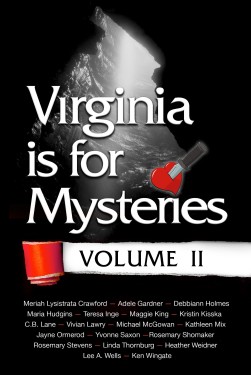It’s Not Always a Mystery Has Moved!!!!!
Debra H. Goldstein has a new website (www.DebraHGoldstein.com) and a new blog location http://www.debrahgoldstein.com/blog/ . Click on the link and continue reading my posts and those of my wonderful guest bloggers on “It’s Not Always a Mystery.” Debra
Guest Blogger Heather Weidner: How Much of Your Fiction is True?
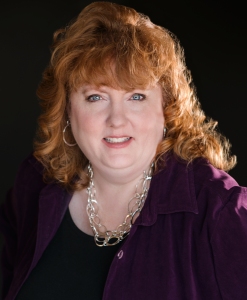 How Much of Your Fiction is True? by Heather Weidner
How Much of Your Fiction is True? by Heather Weidner
Recently, I was asked if any of my mysteries are based on real events or contained real people. I do mix in some real life in my short stories and novels. All of my city settings are actual places. I tend to set my works in Virginia locales. If a crime occurs, I make up that location’s name. I wouldn’t put a horrific event at a real restaurant or store. But if you’ve been to the cities, you’ll recognize landmarks and street names.
Sometimes, I get ideas for crimes and capers from real cases, but I usually take liberties with the details. In my short story, “Washed up,” (Virginia is for Mysteries 2014) a beat up suitcase washes up on Chick’s Beach, and it’s filled with some mysterious contents. Back in the ‘80s, there was a real case where suitcases filled with body parts did wash up on beaches along the East Coast. In my story, I thought it would be interesting for beachgoers to find something old and sinister in an unexpected place.
For some of my characters, I blend characteristics of several real people to make a fictional person. And phrases that family and friends say frequently appear in my stories. I have two co-workers who keep asking me to make them villains. I haven’t done that yet, but I do hint from time to time that unruly team members will end up in a dumpster in a future story.
I carry a notebook with me wherever I go and always jot down names and interesting tidbits that might one day make their way to a story. I use friends and family member’s names for minor characters. In Secret Lives and Private Eyes (June 2016), my sleuth, Delanie Fitzgerald, gives herself all kinds of aliases during her investigations. These are usually names of friends and family. And every once in a while, you’ll find police, EMTs, or FBI agents named after my favorite authors, rock stars, or actors. Delanie Fitzgerald is named for F. Scott Fitzgerald, and her company, Falcon Investigations, is in honor of Dashiell Hammett’s The Maltese Falcon.
tidbits that might one day make their way to a story. I use friends and family member’s names for minor characters. In Secret Lives and Private Eyes (June 2016), my sleuth, Delanie Fitzgerald, gives herself all kinds of aliases during her investigations. These are usually names of friends and family. And every once in a while, you’ll find police, EMTs, or FBI agents named after my favorite authors, rock stars, or actors. Delanie Fitzgerald is named for F. Scott Fitzgerald, and her company, Falcon Investigations, is in honor of Dashiell Hammett’s The Maltese Falcon.
I did have an odd author moment when a woman with the same name as one of my main characters followed me on Twitter. It was a fun surprise.
Even though mysteries are fiction, a great deal of research goes into the project to get the details right and to make it plausible. And surprisingly, there can be quite a lot of truth in fiction.
~ ~ ~ ~ ~
Heather Weidner’s short stories appear in Virginia is for Mysteries and Virginia is for Mysteries Volume II. Currently, she is President of Sisters in Crime – Central Virginia, and a member of Guppies and Lethal Ladies Write. Secret Lives and Private Eyes is her debut novel.
Originally from Virginia Beach, Heather has been a mystery fan since Scooby Doo and Nancy Drew. She lives in Central Virginia with her husband and a pair of Jack Russell terriers.
Follow Heather at www.heatherweidner.com and on Facebook, Twitter, Instagram, and Goodreads.
Secret Lives and Private Eyes Synopsis
Business has been slow for Private Investigator, Delanie Fitzgerald, but her luck seems to change when a tell-all author hires her to find rock star, Johnny Velvet. Could the singer whose career purportedly ended in a fiery crash almost thirty years ago, still be alive?
And as though sifting through dead ends in a cold case isn’t bad enough, Chaz Wellington Smith, III, a loud-mouthed, strip club owner, also hires Delanie to uncover information about the mayor’s secret life. When the mayor is murdered, Chaz, is the key suspect. Now Delanie must clear his name and figure out why landscaper Tripp Payne, keeps popping up in her other investigation. Can the private investigator find the connection between the two cases before another murder – possibly her own – takes place?
Secret Lives and Private Eyes (June 2016) is a fast-paced mystery that will appeal to readers who like a strong, female sleuth with a knack for getting herself in and out of humorous situations.
Guest Blogger Judy Penz Sheluk: Creating a Fictional Town
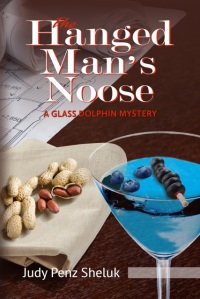 Creating a Fictional Town by Judy Penz Sheluk
Creating a Fictional Town by Judy Penz Sheluk
Agatha Christie was the master of creating atmosphere and place, whether she was at the English seaside, or solving a murder in Mesopotamia. I’ve never been to Minnesota, but when I sit down to read the latest John Sandford novel, I feel as if I’m returning to familiar territory. And anyone who’s read Louise Penny has visited Three Pines, even though it’s a fictional town in Quebec. So when I started writing The Hanged Man’s Noose, I wanted the book to be set in Canada, more specifically, a small town north of Toronto, Ontario. The town would be fictional, but there would a basis for the setting, places that were familiar to me.
At the time, I was living in Holland Landing, a small community in the town of East Gwillimbury, about 35 miles north of Toronto. There isn’t a lot of industry in the Landing, unless you count a couple of local diners, pizzerias, convenience stores and the like, but the neighboring town of Newmarket has a lovely revitalized Main Street filled with indie shops and restaurants, and there’s a nice park at the end of it, complete with a large pond called Fairy Lake. What both East Gwillimbury and Newmarket have in common is growth. In recent years, farmlands and forests have been razed for housing developments and big box stores, with much more planned.
Such growth does not come without contention. We tend to forget that our own homes often sit on plots of land that were once forests and farms. But reading about the latest plans, listening to the groups hotly opposed, gave me the first germ of an idea. What if a greedy developer from Toronto came to a small town with plans to build a mega-box store on the town’s historic Main Street?
That’s the premise behind The Hanged Man’s Noose, the first in the Glass Dolphin mystery series, although the plot does thicken considerably. One reviewer (Jack Batten, WHODUNIT, The Toronto Star) wrote, “In her first book, Toronto writer Judy Penz Sheluk probably scores a record for the most characters with skeletons in the closet … even the sleuth figure, an investigative reporter, guards a personal mystery in a book whose author hits large in the business of concocting secrets.”
I decided to merge Newmarket and East Gwillimbury, borrowing a bit from each, and embellishing a lot. I wanted this to be the sort of idyllic town I’d like to live in. Naming my fictional town was easy: outside the Holland Landing Library and Community Centre,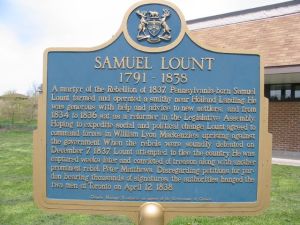 there is a plaque dedicated to Samuel Lount, a 19th century politician who had lived in the Landing, but had the misfortune of being hanged for treason.
there is a plaque dedicated to Samuel Lount, a 19th century politician who had lived in the Landing, but had the misfortune of being hanged for treason.
What could be more perfect for a mystery than a town named after a traitor? Lount’s Landing was born, and along with it, a historic Main Street that includes the Sunrise Café (suspiciously similar to the now-closed Sunshine’s Café in the Landing), and the Glass Dolphin antiques shop, from which the series gets its name. The title of the book comes from name of the local pub, The Hanged Man’s Noose (the owner is a bit of a history buff).
Once I had my town, it was time to populate it with characters. But that’s a story for another day. I invite you to read the first three chapters free at http://barkingrainpress.org/hanged-mans-noose/http://barkingrainpress.org/hanged-mans-noose/. If I’ve done my job, you’ll want to read more. If so, you can find it in trade paperback and eBook at all the usual suspects, including Amazon and Barnes & Noble.
~ ~ ~ ~ ~
 Judy Penz Sheluk’s debut mystery, The Hanged Man’s Noose: A Glass Dolphin Mystery, was published July 2015 by Barking Rain Press. Her short crime fiction is included in The Whole She-Bang 2, World Enough and Crime, Flash and Bang, and Live Free or Tri: a collection of three short mystery stories. Judy has also contributed to two multi-author cookbooks, Bake, Love, Write, and We’d Rather Be Writing.
Judy Penz Sheluk’s debut mystery, The Hanged Man’s Noose: A Glass Dolphin Mystery, was published July 2015 by Barking Rain Press. Her short crime fiction is included in The Whole She-Bang 2, World Enough and Crime, Flash and Bang, and Live Free or Tri: a collection of three short mystery stories. Judy has also contributed to two multi-author cookbooks, Bake, Love, Write, and We’d Rather Be Writing.
Judy is a member of Sisters in Crime, Crime Writers of Canada, International Thriller Writers, and the Short Mystery Fiction Society.
In her less mysterious pursuits, Judy is the Senior Editor for New England Antiques Journal and the Editor of Home BUILDER Magazine.
Guest Blogger Carolyn Mulford – Lookng at Your MS
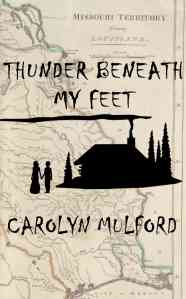 Looking at Your MS by Carolyn Mulford
Looking at Your MS by Carolyn Mulford
Writing a book is a long, hard slog. Typing the last word of the first draft brings a moment of exultation and an evening of celebration. I go to sleep confident the plot intrigues, the characters appeal, and the language delights.
The next morning reality hits. Knowing I will find countless imperfections as I rewrite 330 pages, I suffer an episode of the second-draft blues.
These blues aren’t unique to novelists. I discovered a low follows the first-draft high when writing feature articles for magazines. Working as a magazine editor, I confirmed that almost every writer shares my inability to read our own words objectively right after completing a draft and can’t judge what the rewrite will entail. I devised a visual assessment system, an objective way a writer or editor can judge what kind of work and how much a manuscript needs.
I adapted the system to novels years later while writing Show Me the Murder, the first book in my mystery series featuring a former CIA covert operative who returns to Missouri. She solves rural crimes with two childhood friends. By the time I finished the draft of the just-released fourth book, Show Me the Ashes, I’d begun to share the system with other novelists.
Murder, the first book in my mystery series featuring a former CIA covert operative who returns to Missouri. She solves rural crimes with two childhood friends. By the time I finished the draft of the just-released fourth book, Show Me the Ashes, I’d begun to share the system with other novelists.
By following these three simple steps, a writer or editor can estimate how much work a first draft will need.
Riffle or scroll through your entire manuscript.
If pages look gray, expect long descriptions, info dumps, telling rather than showing. Lots of work to be done, including cutting and moving information.
Watch for long sections of dialogue or long sections without dialogue. An imbalance may signal a pacing or structural problem.
Turn through each chapter.
Do the same visual check as above.
Summarize the chapter’s action in one sentence. If nothing happens or half a dozen different things vie for attention, the chapter needs a rewrite, not an edit.
Read the end of the chapter to see if it propels the reader to the next chapter. If it doesn’t, you may need to end the chapter in a different place.
Read the opening to see if the reader who put down the book will be lost. Readers tend to stop at the end of a chapter and may not start the next chapter for days.
Look at each page.
If you see only two or three paragraphs, anticipate some rewriting.
Check the first word or phrase of each paragraph. If all or most paragraphs start the same way, you’ll be editing that page. Anticipate slow going.
Look for periods. If most sentences are long or the same length, prepare to edit. You’ve been using your eyes. Use your ears, too. Read aloud to check sentence structure, sound, emphasis, and rhythm.
Read the verbs.
The verbs alone should summarize what happens on that page. If they don’t, replace weak verbs. Look for forms of to be, verbs with modifiers, and passive voice. Strong verbs produce shorter, more dynamic sentences.
The visual assessment system won’t yield a comprehensive analysis of our first drafts, but it indicates how much we still have to do and guides us in the rewrite.
Using the system doesn’t prevent the second-draft blues.
~ ~ ~ ~ ~~~~~
Carolyn Mulford worked as a magazine editor and freelance writer on five continents before moving back to her home state of Missouri and focusing on fiction. She writes the award-winning Show Me series, character-driven mysteries featuring three women: Phoenix Smith, a former spy who adapts her tradecraft to solve crimes in her hometown; Annalynn Keyser Smith, a civic leader who becomes sheriff after her husband’s violent death; and Connie Diamante, a struggling singer who uses improv to extract information. Achilles, a K-9 dropout, serves on their team. The fourth book, Show Me the Ashes, came out in hardback and e-book March 16. Harlequin Worldwide Mystery will issue a paperback edition of the second book, Show Me the Deadly Deer, in June. Carolyn also writes historical novels for tweens and teens. Thunder Beneath My Feet, set during the devastating New Madrid earthquakes of 1811-1812, came out in February 2016. The first chapter of each book appears on Carolyn’s website: http://carolynmulford.com.
focusing on fiction. She writes the award-winning Show Me series, character-driven mysteries featuring three women: Phoenix Smith, a former spy who adapts her tradecraft to solve crimes in her hometown; Annalynn Keyser Smith, a civic leader who becomes sheriff after her husband’s violent death; and Connie Diamante, a struggling singer who uses improv to extract information. Achilles, a K-9 dropout, serves on their team. The fourth book, Show Me the Ashes, came out in hardback and e-book March 16. Harlequin Worldwide Mystery will issue a paperback edition of the second book, Show Me the Deadly Deer, in June. Carolyn also writes historical novels for tweens and teens. Thunder Beneath My Feet, set during the devastating New Madrid earthquakes of 1811-1812, came out in February 2016. The first chapter of each book appears on Carolyn’s website: http://carolynmulford.com.
Guest Blogger Kathy Waller – Three Ways of Looking at Austin Mystery Writers or, Why I go to Critique Group
 Three Ways of Looking at Austin Mystery Writers or, Why I Go to Critique Group by Kathy Waller
Three Ways of Looking at Austin Mystery Writers or, Why I Go to Critique Group by Kathy Waller
#1 Yesterday Dominica felt faint, and Molly, my protagonist, steered her to a bench on the courthouse lawn and then dithered over what to do. She couldn’t leave Dominica there to topple off the bench, but asking a passerby for help sounded lame, and there weren’t any passersby to ask. So there was poor Molly, needing more help than I could give her, stuck any way you looked at it. She stayed that way all night.
Today, talking about treatments for migraines, one of my critique partners took a bottle of peppermint oil from her purse and passed it around. At the first whiff, I said, “Molly suffers from migraines! She carries peppermint oil in her purse! She can use that to revive Dominica.”
In one fell swoop, I both saddled Molly with migraines and solved a knotty problem.
That is why I go to critique group.
#2 I said to my critique partners this morning, The whole project is stinky it stinks it’s just nothing no hope.
They said, But it’s so good so funny Molly is so funny it’s not stinky.
I said, Yes, the first part and the last part are funny and very very good but there’s still no middle and what there is stinks and anyway the other 5,000 words stink except for a few hundred here and there.
And they said, But the middle could be revised edited it has promise.
I said, But it won’t work because I have written myself into a hole and can’t get out so I have to trash that part and anyway the whole concept stinks.
And they said, NO you can fix it just keep going because we like Molly she’s so funny.
This is why I go to critique group.
#3 So I finally got things together with a beginning, a middle, and an end, and today my critique group said it was fine. But…
“Nobody died,” said Kaye.
“I know,” I said. “It’s li-ter-a-ry.”
“But it’s crime fiction,” said Gale. “Somebody has to die.”
Laura and Valerie, sitting on the other side of the table, nodded. In unison.
“I was going for subtlety,” I said. “It’s a death of the spirit.”
They stared at me. I stared back.
“Somebody has to die,” said Kaye.
Then all four said they didn’t understand the last line. I had written the entire story so I could use that line, and no one understood what it meant.
I kept staring and thought about words like philistines, peasants, and bourgeoisie.
Finally I spoke. I said, “Thank you.”
Then my friends began throwing out ideas for endings they liked, in each of which someone died. I sighed and said, Yeahhhh, and, Okayyyy, and, I guessss…
Gad, they were irritating, telling the truth like that. Especially the way they all kept agreeing. Especially since I’d known the ending was bad before I let them read it.
And then Kaye said, XXX—and I thought, YYY—and everything fell into place: I knew who would die, and how, and why, and what would happen next…
And I thought, Kaye has given me the perfect ending. All the suggestions are good, but hers works on multiple levels. It’s so right. Why didn’t I think of it myself?
And then I thought, Oh, who cares about why. What matters was that Kaye thought of it, and shared it, and that she and three other writers not only told the truth but grabbed me by the lapels and made me listen.
I rewrote the story, and it was published in Austin Mystery Writers’ crime fiction anthology, Murder on Wheels.
And that is why I go to critique group.
Every. Blessed. Week.
###
Kathy Waller’s A Nice Set of Wheels and Hell on Wheels appear in Austin Mystery Writers’ crime fiction anthology Murder on Wheels (Wildside Press, 2015). A former librarian, former teacher, former paralegal, and former pianist for a string of churches desperate for someone who could find middle C, Kathy was born and reared in a small (pop. 150) town in Central Texas, and as a result nearly everything she writes includes a river, a cow, or a group of old ladies playing dominoes on someone’s front porch.
Writers’ crime fiction anthology Murder on Wheels (Wildside Press, 2015). A former librarian, former teacher, former paralegal, and former pianist for a string of churches desperate for someone who could find middle C, Kathy was born and reared in a small (pop. 150) town in Central Texas, and as a result nearly everything she writes includes a river, a cow, or a group of old ladies playing dominoes on someone’s front porch.
Guest Blogger Tracy Weber: A Perfect Place for Murder

Green Lake Park – A Perfect Setting for Murder
A Perfect Place for Murder by Tracy Weber

Tasha, the real-life Bella watching the activities on Green Lake’s inner path
I enjoy getting fresh air and exercise while scanning for wildlife, including turtles, squirrels, geese, raccoons, and blue herons.

One of Green Lake’s Blue Herons – can you spot his turtle friend?
In the summer, the area near the lake’s shore is smothered with lily pads; its surface, dotted by boats. The path around its circumference is crowded with thousands of locals who flock to it each day. What better place to plot murder!

Green Lake’s Ocean of Lily Pads
When yoga teacher/sleuth Kate Davidson agrees to teach a Doga (yoga for dogs) class at Greenlake, she has no idea that the area will soon be the site of a murder. In the excerpt below, Kate witnesses an argument between two women hidden behind a stack of paddleboats.

Scene of the Excerpt
Excerpt from Karma’s a Killer
Yoga instructor Kate Davidson is about to discover that when it comes to murder, there’s no place like om. When she agrees to teach doga—yoga for dogs—at a fundraiser for Dogma, a local animal rescue, Kate believes the only real damage will be to her reputation. But when an animal rights protest at the event leads to a suspicious fire and a drowning, a few downward-facing dogs will be the least of Kate’s problems…

Tracy Weber – Author
Tracy Weber is the author of the award-winning Downward Dog Mysteries series. The first book in the series, Murder Strikes a Pose, won the Maxwell Award for Fiction and was nominated for the Agatha award for Best First Novel.
Holiday Happiness vs. Happy Holidays by Debra H. Goldstein

Holiday Happiness. Happy holidays. One and the same? Not by a longshot.
The phrasing of “holiday happiness” and happy holidays” is the difference between a state of being versus a wish. Not everyone has the opportunity or the desire to experience either.
During the past the few weeks, everywhere I went, people told me “Happy Chanukah,” “Merry Christmas,” “Have a Happy New Year,” “Seasons Greetings,” or “Happy Holidays.” TV commercials advertised joyful times, products for sale, and also wished me some form of a “Happy Holidays.” Radio music, that began blaring on our local Christmas channel before Thanksgiving, set the stage and mood by having lyrics that sent a subliminal “Happy Holidays” message.
I got it. I participated. Even when I felt most Grinch like, I responded or automatically was the first to let one of these phrases roll from my lips. Why? Because no matter how one feels inside, one has been conditioned to share a prayer for others to have a “Happy Holidays.” It is the right thing to do. In fact, it is the only thing to do.
No matter how many times we say these words, they aren’t necessarily going to result in an individual experiencing “Holiday Happiness.” We hope it will, but we can’t count on it. The world and life isn’t always perfect. Parents, friends, and other family members may be ill, aging, or dying during this period of the year. Some people may be short of money, have problems with jobs, co-workers or lack of employment, and some are simply without the economic resources for food and shelter.
Like the wishes for “Happy Holidays,” words of platitude and caring are expressed. People make donations of food, money, and gift items in the hope of improving the holidays for others. Many feel good giving something that brings “Holiday Happiness” to others. Not only does it make a difference in the recipient’s life, but it warms the heart of the giver.
I am a realist. There have been years that I have felt the joy of “Holiday Happines” and other times where the holiday season has been meaningless. Last year was tinged by the loss of my mother. This year, with a book coming out in April and two stories published during the December holiday period, it has been an up time professionally. With anticipated weddings, visits to children, grandchildren and granddogs, and other planned trips with family and friends, I look forward to an exciting and wonderful 2016 for my loved ones and me.
Not all of you who read this message will experience the perfect definition of “Holiday Happiness,” but at least I can wish and pray for it for you. May the remainder of the holiday season and the upcoming year be one of health, happiness and prosperity. “Happy Holidays!”
 I broke the string of titles this week with the launch of a novella about my detective who has a strong role in my Endurance mysteries. Oh, I know Ben Franklin is probably disappointed that I didn’t use one of his proverbs this time, but my novella is also a break in a string of full-length novels.
I broke the string of titles this week with the launch of a novella about my detective who has a strong role in my Endurance mysteries. Oh, I know Ben Franklin is probably disappointed that I didn’t use one of his proverbs this time, but my novella is also a break in a string of full-length novels.
